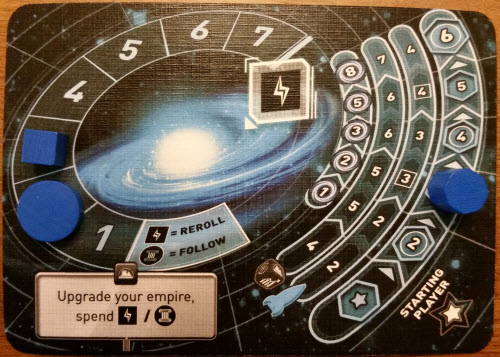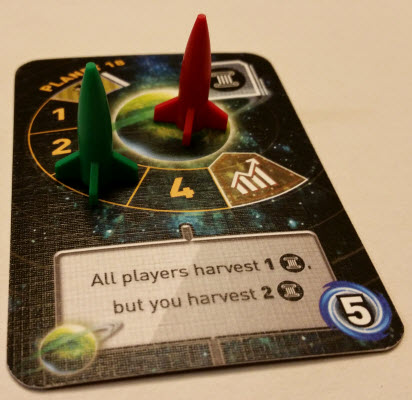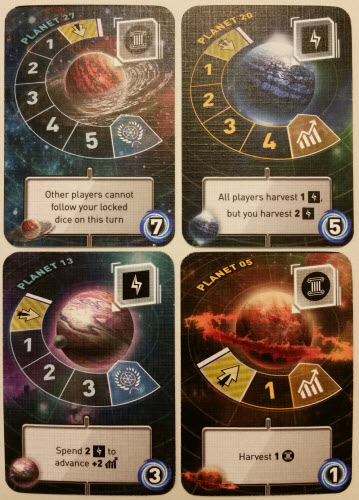Space is big. You just won’t believe how vastly, hugely, mind-bogglingly big it is. I mean, you may think it’s a long way down the road to the chemist’s, but that’s just peanuts to space.
– Douglas Adams
Alright, sure, space – real space – is impressively big. It’s like watching a TV so big you can see the bacterium on the skin of the person on the screen or finding an inexpensive taco that won’t break apart kind of impressive. So, the mere idea of our present civilization turning into an interstellar empire that can compete out in the vast sprawl of the Orion Arm is a bit hard to comprehend.
However, one can conquer the totality of the Coffee Table Galaxy with far greater ease. And Tiny Epic Galaxies is just the sort of game to do it.
In the latest saga of the Tiny Epic series by Scott Almes, people within this pocket universe have advanced far off into space, growing into massive empires. As is it turns out, though, their space holdings still aren’t big enough for their ambitions, so now is the time to expand yet again. But in this small form game for 2-4 players, other empires have decided that now is the right time for them to do the same. Thus, the race for control of the known Coffee Table Galaxy is on in this small but competitive civ-building dice game!
In a race to 21 VP, Tiny Epic Galaxies begins with each player starting in their own tinier, slightly less epic region of space. To get there, players will spend time trying to colonies planets and grow the scope of their dominion.
(But hey, everyone’s gotta start somewhere.)

A player’s slightly upgraded homeworld.
Prototype Shown
Each of these homeworlds provide players two initial ships for flying about, but just as importantly, they track just how much clout you have to throw around. The game works off just two resources: Energy, representing the materials and effort required to expand your reach out into the void, and Diplomacy, representing your cultural influence on places that have learned it’s better to welcome your leadership than go through all the pesky trouble of being conquered.
How you get these resources, and by extension the VP needed to win, is through the use of the game’s action dice. In what is ostensibly a strategy-driven dice game, Tiny Epic Galaxies revolves around you rolling a set number of dice every turn and what you plan to do with them. Yet one of the two particularly noteworthy things about this small dice-based romp around the universe is the ample room it offers you to alter your fortune should those rolls go awry.
Tiny Epic Galaxies helps set itself apart from similar games in its weight class by providing multiple opportunities to avoid being stranded due to poor luck due from a malfunctioning hyperdrive, er, die roll. When you roll your dice, for example, you’re permitted to reroll any number of unallocated dice once for free. However, you may then continue to reroll unallocated dice as many times as you wish at a cost of 1 Energy each time. Given that you can never have more than 7 Energy or Diplomacy, this can can drain your interstellar coffers if done frequently, but the option is there. Moreover, each turn you also have the ability to sacrifice two unused dice in order to set a third to any result you desire. Initially this too is prohibitive (since you only roll four dice to start), but as the game moves along and your power grows, getting the right results could be the difference between victory and crushing defeat.

Reference approved.
Which actions you take during these dice rolls are the core of Tiny Epic Galaxies, and these six-sided dice provide you with seven different possibilities.
Yes, you read that right. These dice go to seven.
The majority of these actions involve the very planets you and your inferior opponents are fighting over. The game comes with a variable number to focus on at any given time, and if one planet is claimed, another takes its place. Every planet exists as either an Energy or Diplomacy generating planet, has a unique ability, a colonization track, and a VP amount if taken.
The game’s dice actions include:
-

Red landed on this planet. Green is two steps from colonizing it.
Land On The Surface: Move one of your ships to the surface of a planet card for the planet’s innate ability.
- Land on the Colonization Track: Move one of your ships to the first space on a planet’s colony track. Each colony track is either influenced by Diplomacy or Economy. While this initially gets you nothing, if your ship reaches the end of the track first, the planet is added to your empire. This gives you sole access to the planet’s ability, as well as its VP value.
- Energy: Gain 1 Energy for each ship you have on Energy planet cards.
- Culture: Gain 1 Culture for each ship you have on Culture planet cards.
- Diplomacy: Advance 1 ship you have on a colony track requiring Diplomacy.
- Economy: Advance 1 ship you have on a colony track requiring Economy.
- Colony: Use an action available to you at HQ. Initially, this only allows you grow the size of your empire by spending Energy or Culture. Doing so increases your access to more ships, more dice to roll, and ever-precious VP. However, as your…let’s say peaceful…influence grows, you can instead used this action for any planet ability you’ve claimed.
Left simply at this, Tiny Epic Galaxies would mostly just be a game of scrambling for the right die results, putting it just a notch above Press Your Luck games. However, you aren’t simply limited to what you roll here. You can benefit from what other people roll as well.
Borrowing a mechanic seen in a variety of forms in other games such as Puerto Rico, Race For the Galaxy, or Eminent Domain, the other particularly noteworthy thing about Tiny Epic Galaxies is that it offers each player the option to “follow” another player’s action by spending 1 Culture. If your opponent uses an Economy die action, for instance, each other player can spend a Culture and also take that action.
The ramifications for this are threefold. First, it makes the game faster – which is sort of ideal for a game designed to only be played in 30 minutes. Second, it makes the game engaging even when it isn’t your turn, decreasing (or eliminating) downtime.
Last, and most importantly, is that this mechanic adds more depth to the game without making it more complicated and more cohesive without becoming rigid. If you have no Culture, or simply don’t want to spend it, you’re not required to. (But then, really, what kind of empire are you running exactly?) The use of everyone potentially benefiting from actions adds a far more interesting dynamic to the game, as players can claim planets, gain resources, and grow their empire at any given time rather than having to sit on your hands while a lucky roller gobbles up the known universe.
Tiny Epic Galaxies may be short on play time, but it isn’t short on quality. It avoids the normal trappings of many lighter dice-based games by giving numerous ways to mitigate poor luck roles – albeit at different costs – and its gameplay is all the better as a result. The use of spending resources to further your goals whenever it’s advantageous to you not only keeps players focused on the game, but it ensures that this race for planets feels truly contested, as players must make decisions over which planets to compete for, which to abandon, and when it isn’t worth the investment. The game, however, certainly is. Tiny Epic Galaxies is the third iteration of Gamelyn’s Tiny Epic series, and it may be the best one yet. To that end, if you’d like to try your hand at ruling the Coffee Table Galaxy, then take an FTL jump over to the Kickstarter!
[sc:Preview-Sealer ]Photo Credits: Spinal Tap by MGM Studios.

